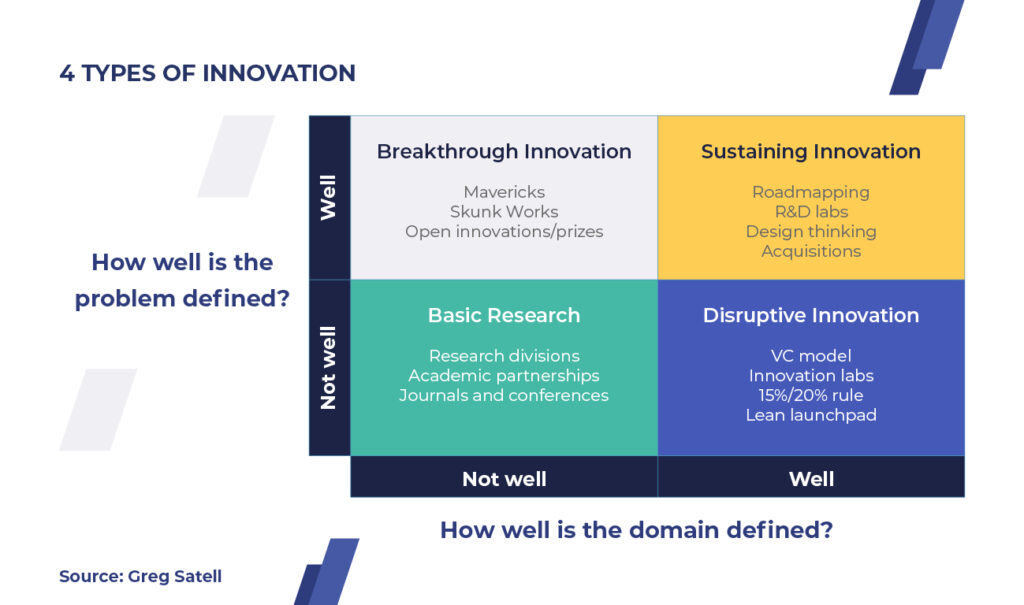Aviation will need to innovate out of COVID, that much is certain. But how can airlines, suppliers, original equipment manufacturers and other players in the ecosystem best set themselves up to innovate? Analysing the problem across a matrix of how well a problem — and the skill domains that are needed to solve it — are defined can reveal enlightening insights.
Back in 2017, Eric Satell framed innovation into four quadrants for the Harvard Business Review. In terms of his quadrants, beyond what we might today call the business-as-usual basic research parts of an innovation ecosystem — research divisions, academic partnerships, journal work, trade conferences, and so on — the breakthrough innovation, disruptive innovation and sustaining innovation that aviation will need to emerge stronger from the pandemic crisis will be crucial.

Breakthrough innovation needs to be nurtured for big bang technology to emerge
Breakthrough innovation comes when a problem is well-defined, but the skill domains to solve them are not.
Any aviation history buff’s eyes will immediately snap to the words “Skunk Works” on the diagram here. Lockheed’s innovation department is so well known that it is a byword for breakthroughs: the P-38 Lightning through the U-2, the SR-71 Blackbird, the F-117 Nighthawk, and today’s F-22 Raptor and F-35 Lightning II… as well as a few that the rest of us almost certainly don’t know about yet.
The best practices for a skunkworks are, of course, written down in the Skunk Works’ legendary creator Clarence “Kelly” Johnson’s 14 Rules & Practices.
Even today, it is striking to read Johnson’s focus on small, nimble teams, strong requirements capture, delegated responsibility, a minimum of overhead administration work, and the need to reward technical expertise without promotion to management.
What’s next for a breakthrough in commercial aviation — hydrogen-powered airliners? Battery-powered commuter and regional aircraft? Solar-powered flight? Uncrewed cargo delivery or even cargo airliner flights? Spaceflight? Smart materials?
Disruptive innovation is complicated in a highly regulated industry, but can reap rewards
If there’s a word that typifies the kind of innovation in the boom years between the late 2000s’ Global Financial Crisis and the COVID-19 pandemic just over a decade later, it’s “disruption”: tech-based, marketplace-shifting changes in the landscape that redefine entire industries.
It’s “the Uber of X”, with the aim being to build billion-dollar unicorn startups. It’s the 15% rule that 3M started after the almost accidental creation of the Post-It note or Google’s 20% time, hoping that by encouraging team members to develop their own professional interests the lightning flash of innovation will strike.
But that kind of progression of innovation is much more complicated in a highly regulated industry like aviation than, say, taxis or food delivery, where commercial and service models (and, in these cases, the hardware, software and digital integration that run them) are more clearly defined.
Fractional ownership private aviation services fit into this disruptive category, with their shiny apps and promises of reduced rates. VTOL and eVTOL aircraft — air taxis, flying cars, urban air mobility, call it what you will — also sit here, not least down to the amount of venture capital backing them.
Sustaining innovation focuses on iterative and evolutionary change
Sustaining innovation may feel unsexy compared with the other two, but it’s just as important to get right, if not more so. Doing what you do better is vital, whether that’s through processes like lean manufacturing, Toyota-style kaizen or continuous improvement, all the way through the promises of Industry 4.0 connected manufacturing and beyond.
Mergers and acquisitions, research and development, design thinking and roadmapping, skills and learning — this is the vital stuff of any industry, but particularly one that has a unique set of externalities in terms of safety regulation, national and international contexts, and a very high capital requirement.
Sustaining aviation drives much of the airline digitalisation agenda, including AI, big data, predictive analytics, the Internet of Things, VR and AR, and more. Creating more sustainable fuels for existing aircraft, too, is the kind of sustaining innovation that can reap real rewards.
Fundamentally, in order to enable an organisation to be disruptive and to achieve breakthroughs in the 2020s and beyond, being able to sustain those innovations with the latest digital tools — and to make the space and time to create breakthroughs and disrupt the industry — will be crucial.
Author: John Walton
Published: 25th November 2021



